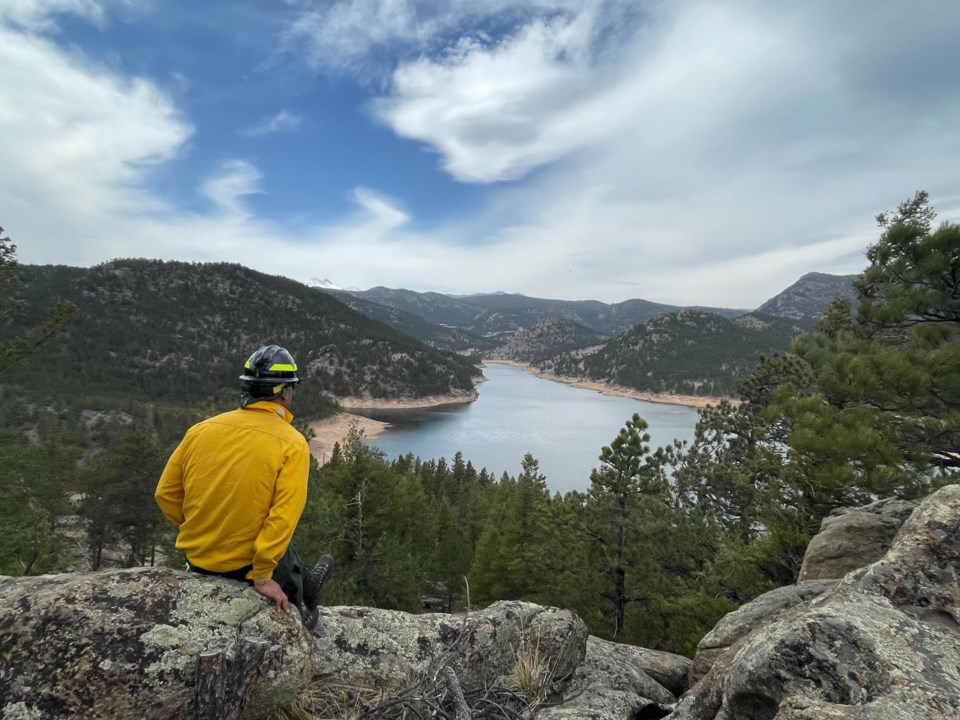A $1 million grant will help protect water supply and reduce risk of wildfire in Longmont and Boulder County.
The St. Vrain Watershed has long been recognized as a vital landscape that is at risk for catastrophic wildfire due to overly dense forests and increasing drought. Entities in the St. Vrain area have teamed up to begin addressing these issues across jurisdictions.
Last week, Boulder County announced that it has received a $1 million state grant for the first phase of the St. Vrain Forest Health Partnership Project from the Colorado Strategic Wildfire Action Program (COSWAP) Landscape Resilience Investment.
The grant will be matched with cash and in-kind matches from Boulder County, Longmont, the Boulder Valley and Longmont Conservation District and Left Hand Watershed Center for a total match of over $1.2 million. The project budget is $2.2 million.
The project will complete critical landscape-scale forest restoration projects within the St. Vrain Watershed to reduce risk to communities, water supplies and forests, according to the county.
The projects include a 76 acre forest restoration project at Hall Ranch led by Boulder County Parks and Open Space, 130 acre project near Lyons led by Boulder Valley and Longmont Conservation Districts, 140 acre project near Ralph Price Reservoir led by Longmont and 4,000 acres of cross-boundary forest restoration plans led by the Left Hand Watershed Center.
Pryce Hadley is the senior watershed ranger for Longmont, and his primary responsibility is protecting the city’s drinking water supply at Ralph Price Reservoir in the Button Rock Preserve. Longmont is planning two forest restoration protection projects near the reservoir to begin in 2023, Hadley said.
The larger of the two projects is the Cook Mountain Project, which will be funded in part by this recent state grant. Hadley explained that the work will involve thinning roughly 140 acres around Cook Mountain, the ridgeline west of Ralph Price Reservoir that forms the boundary between Button Rock Preserve and the Arapaho-Roosevelt National Forest.
“While areas of Cook Mountain have been thinned in the past, most stands remain overly dense and prone to mistletoe infestation and wildfire,” Hadley said. “The project will improve habitat and create a valuable fuel break to the west of Ralph Price Reservoir that will help protect the city's drinking water supply.”
Longmont also is working on the Button Rock Watershed Protection Project that will treat 50 acres on the north shore of Ralph Price Reservoir. That project is made possible by a different COSWAP Workforce Development Grant, which will fund 18 weeks of labor by specially trained Larimer County Conservation Corp sawyer crews.
This project will thin stand density and create a crucial fuel break downhill of the preserve’s only emergency egress while building job skills, Hadley said.
Longmont is one of several stakeholders in the St. Vrain Forest Health Partnership.
“City of Longmont is an active member of this partnership and continues to prioritize forest stewardship and resource protection in management of Button Rock Preserve and the City's drinking water watershed,” he said.
The Longmont and Boulder Valley Conservation Districts are leading a 130-acre project near Lyons, which is shovel-ready, according to District Manager Vanessa McCracken. The project north of Lyons is expected to start next spring and involves work on private land.
“Forest restoration and fire mitigation are high priorities for most of Boulder County,” McCracken said. “This project had some very excited landowners who were ready and willing to go forward with this project. The location is such that it will provide some fire protection for the town of Lyons and neighboring communities as well.”
Like the Ralph Price projects, the work will focus on thinning the overly dense forest to improve forest health and reduce the chances of extreme wildfire.
“The kind of condition we’re trying to get back to is a landscape where fire is not nearly as intense, but it’s more of a natural ecological phenomenon,” she said.
As part of the collaboration — but not the specific grant — Roosevelt National Forest managers recently released a proposal to consider similar work on National Forest lands. Following an environmental analysis, National Forest land managers will be ready to participate in the cross-boundary treatments proposed as part of this effort.



